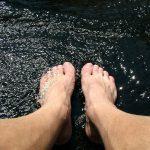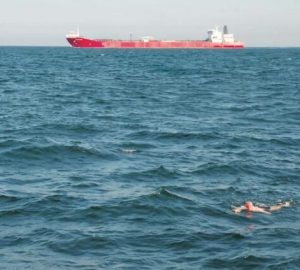Beware the perils of overconfidence – and some tips on swimming straight
Having completed a reasonably large number of open water swims I believe (at least, I believed until now) that I had pretty much mastered the skills of sighting and swimming straight. So confident was I in my abilities that this weekend, at a choppy but scenic swim in Poole, I was happily powering towards the bright red turning buoy when a friendly kayaker stopped me and pointed me in another direction. It hadn’t occurred to me that I might be heading towards the wrong buoy. What I imagined to be laser-like focus on my goal was in fact tunnel vision.
The course was set out as a 750m perimeter rectangle. During my second of the four laps I somehow contrived to swim diagonally across the course rather than along the edge. I wasn’t pleased about the extra distance I had to swim to get around the buoy I should have been aiming at in the first place.
As well as throwing doubt on my sighting capabilities, the incident also prompted me to consider my ability to swim straight. How had I managed to deviate something like 30 degrees from the direction I thought I was going? I’ve always been puzzled when I’m next to someone in open water why they keep barrelling into me or if I’m following someone why do they change direction every few strokes. Can’t they swim straight?! But after today’s experience I’m beginning to wonder if I’m something like the character in the joke whose wife phones him to warn about someone driving the wrong way up the motorway and he replies: “it’s not just one, it’s hundreds of them.”
The problem is it’s actually very hard to tell if you are swimming straight on your own. You can practise sighting as much as you like but if you don’t get any feedback, how will you know you are getting better and swimming straighter? Firstly you need to identify whether or not you have a problem; secondly you need to fix it.
Here are some indicators that you’ve got a problem with sighting and swimming straight:
1) You make a massive navigational blunder
2) Your performance in open water is significantly worse (relatively speaking) than your performance in the pool (note: there may be other reasons for this).
3) If you use a GPS device, your measured distance is much greater than the official distance of the course (if it has been accurately measured) or that of other swimmers who’ve also tracked the course.
4) A plot of your swim looks like saw teeth rather than a knife edge.
5) You frequently swim into people when in a pack (it might not be their fault!)
6) Other swimmers tell you that you don’t swim straight.
So, if you do identify you are perhaps a little less skilled in the swimming navigation department than desirable, how do you fix it? Practise, obviously, but your practice needs to be purposeful, which means you need to get immediate feedback. Here are a few things you can do:
1) In all your swimming, try to reduce and eliminate non-symmetrical elements, including (especially) your breathing. Try to get some coaching or at least get a friend to film you.
2) In a pool (and when you have a lane or plenty of space to yourself) try swimming with your eyes closed. How far can you go before you hit the lane rope? Ask a friend to watch to make sure you don’t hurt yourself. Repeat while trying to compensate for any drift and try to swim further each time.
3) In open water, ask a friend to stand on the bank and film you as you swim towards her. Watch the film immediately to see if you veer off to one side or another. Repeat several times taking increasing numbers of breaths between each glance. See what difference it makes.
4) Become more aware of everything you can see around you, not just the point you are aiming for. What you see when you turn your head sideways to breathe can really help you swim straighter. Practise this by swimming longer distances using only the cues you get when turning your head sideways and check how you’ve got on by sighting perhaps after 20 or 30 strokes rather than the usual four to 10.
5) However good you are at swimming straight, and however confident you are in your abilities, always allow for the possibility that you might not be as good as you think and double check you’re heading for the right target.
Finally, don’t get too stressed about it. After all, the further you swim, the more value for money you are getting. And, as open water swimming is as much about the experience as your time at the finish line, remember that a meandering line gives you more opportunities for random encounters that might just make your day.







